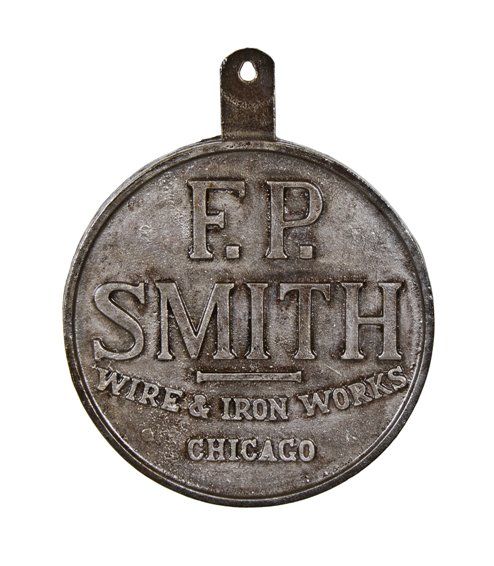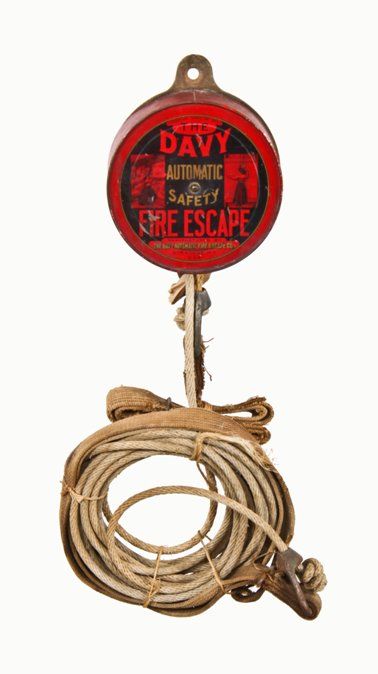newly refinished early 20th century chicago building movable fire escape section counterweight with deeply embossed lettering
SOLD
Out of stock
SKU
UR-12563-12
f.p. smith wire & ironworks co., chicago, il.
early 20th century city of chicago building artifact in the form of a heavy circular counterweight salvaged from the movable section of an exterior fire escape. the newly refinished counterweight features deeply embossed letter manufacturer markings along the faceplate. the counterweight was fabricated by the f.p. smith wire & ironworks co., chicago, il. a fire escape consists of a number of horizontal platforms, one at each story of a building, with ladders or stairs connecting them. the platform and stairs are usually open steel gratings, to prevent the buildup of ice, snow, and leaves. railings are usually provided on each of the levels, but as fire escapes are designed for emergency use only, these railings often do not need to meet the same standards as railings in other contexts. the ladder from the lowest level of the fire escape to the ground may be fixed, but more commonly it swings down on a hinge or slides down along a track. the moveable designs allow occupants to safely reach the ground in the event of a fire. one of the first fire escapes of any type was invented in 18th-century england. in 1784, daniel maseres, of england, invented a machine called a fire escape, which, being fastened to the window, would enable anyone to descend to the street without injury. abraham wivell created an improved design after becoming superintendant of the "royal society for the protection of life from fire." anna connelly patented the first fire escape in 1887, which was designed with an exterior staircase. by 1888 the us had granted 1,099 patents on fire escapes of "many forms, and of every possible material." as building codes became more common in countries around the turn of the 20th century, fire safety became an important concern for new construction. building owners were increasingly required to provide adequate escape routes, and at the time, fire escapes seemed the best option available. not only could they be included in new construction at a low cost, but they could be very easily added to existing construction. as building codes evolved and more safety concerns addressed over subsequent editions, all construction above a certain number of stories was required to have a second means of egress, and external fire escapes were allowed as a retrofit option for existing buildings prior to the post-world war ii period. in the 1930's the enclosed tubular chute type fire escape became widely accepted for schools, hospitals and other institution replaced the open iron ladder type. its main advantage was people would have no reason to use it for another other than a fire escape and patients could be slid down it in a fire on their bedding. however, with the urban sprawl and increase in the amount of construction in the mid-20th century, particularly the increase in public housing in major cities in theunited states and europe in the 1950's and 1960's, certain problems with fire escapes became clear. in the poorer areas of cities like chicago and new york, fire escapes were commonly used for everything but their intended purpose. in the hot summer months, residents of mid-rise apartment buildings would sleep outside on the platforms of their fire escapes. such a situation triggered the plot premise of cornell woolrich's 1947 short story, "the boy cried murder," about a boy on a fire escape who one night witnesses a murder in a neighboring apartment; this story was filmed as the suspense thriller the window (1949). the practice of sleeping on fire escapes can also be seen in alfred hitchcock's 1954 movie rear window (also based on a woolrich short story), as well as weegee's photography of the lower east side). diagonal shadows of fire escapes made them a constant motif in film noir, and the balcony scene of romeo and juliet was transposed to a fire escape for the musical west side story. boston herald american photographer stanley j. forman won a 1976 pulitzer prize for his powerful photo of two people plunging from a faulty fire escape during a 1975 boston fire, and the controversial, unforgettable image resulted in tougher fire safety codes in some jurisdictions.
WORDLWIDE SHIPPING
If required, please contact an Urban Remains sales associate.
NEW PRODUCTS DAILY
Check back daily as we are constantly adding new products.
PREMIUM SUPPORT
We're here to help answer any question. Contact us anytime!
SALES & PROMOTIONS
Join our newsletter to get the latest information


























